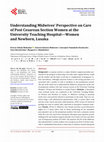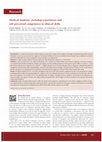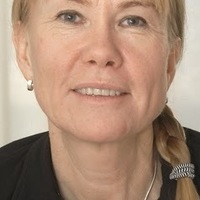Papers by Margaret Maimbolwa

Open Journal of Nursing, 2018
Background: A cesarean section is a major obstetric surgical procedure performed for the purpose ... more Background: A cesarean section is a major obstetric surgical procedure performed for the purpose of delivering a live baby when vaginal delivery would put the mother and the baby at risk due to complications of pregnancy, labour and delivery. Although caesarean section is a life saving procedure, it is associated with a number of risks or problems in the postoperative period. The aim of the study was to understand the Midwives' perspective on the care of postpartum mothers who had cesarean section at the University Teaching Hospital-Women and Newborn in Lusaka District. Methods: A descriptive cross sectional survey was conducted at the University Teaching Hospital-Women and Newborn in Lusaka. 51 Midwives working in postnatal wards were consecutively selected to participate in the study. Data was collected using a self administered questionnaire with a 4 point Likert scale and also some closed and open ended questions. SPSS version 20 statistical package was used to analyse data, expressed as descriptive summary measures. Results: All the 51 Midwives were female and they scored themselves highly on a 4 point Likert scale as always performing all the immediate post-operative care on the postpartum mothers who had a caesarean section while the score was much lower during the subsequent post-operative period. Staffing levels and medical-surgical materials were found to be low and affect care of Postpartum mothers (P-0.050). The majority (94.2%) of the Midwives also indicated that C-section mothers were not given any form of written materials or standardized instructions to take home as reference material during the

African Journal of Health Professions Education, 2014
In a traditional curriculum, medical students are expected to acquire clinical competence through... more In a traditional curriculum, medical students are expected to acquire clinical competence through the apprenticeship model using the Halstedian 'see one, do one, and teach one' approach. The School of Medicine, University of Zambia, Lusaka, Zambia, used a traditional curriculum model from 1966 until 2011, when a competence-based curriculum was implemented. Objective. To explore medical students' clerkship experiences and self-perceived competence in clinical skills. Methods. A cross-sectional survey was conducted among 5th-, 6th-, and 7th-year medical students at the School of Medicine, University of Zambia, two months before the final examinations. Students were asked to rate their clerkship experiences with regard to specific skills on a scale of 1 -4 and their level of self-perceived competence on a scale of 1 -3. Skills evaluated were in four main domains: history-taking and communication, physical examination and procedural skills, professionalism, teamwork and medical decision-making. Using the Statistical Package for the Social Sciences (SPSS), correlations were performed between experiences and self-perceived competence of specific skills, within domains and overall. Results. Of clinical students (N=197), 138 (70%) participated in the survey. The results showed a significant increase in the proportion of students performing different skills and reporting feeling very competent with each additional clinical year. Overall correlations between experience and selfperceived competence were moderate (0.55). For individual skills, the highest correlation between experience and self-perceived competence was observed mainly with regard to medical-and surgical-related procedural skills, with the highest at 0.82 for nasogastric tube insertion and 0.76 for endotracheal intubation. Conclusion. Despite the general improvement in skills and self-perceived competence some deficiencies were noted, as significant numbers of finalyear students had never attempted important common procedures, especially those performed in emergency situations. Deficiencies in certain skills may call for the incorporation of teaching/learning methods that broaden students' exposure to such skills. AJHPE 2014;6(2):155-160.

Academic Medicine, 2014
Zambia is facing a crisis in its human resources for health, with deficits in the number and skil... more Zambia is facing a crisis in its human resources for health, with deficits in the number and skill mix of health workers. The University of Zambia School of Medicine (UNZA SOM) was the only medical school in the country for decades, but recently it was joined by three new medical schools--two private and one public. In addition to expanding medical education, the government has also approved several allied health programs, including pharmacy, physiotherapy, biomedical sciences, and environmental health. This expansion has been constrained by insufficient numbers of faculty. Through a grant from the Medical Education Partnership Initiative (MEPI), UNZA SOM has been investing in ways to address faculty recruitment, training, and retention. The MEPI-funded strategy involves directly sponsoring a cohort of faculty at UNZA SOM during the five-year grant, as well as establishing more than a dozen new master's programs, with the goal that all sponsored faculty are locally trained and retained. Because the issue of limited basic science faculty plagues medical schools throughout Sub-Saharan Africa, this strategy of using seed funding to build sustainable local capacity to recruit, train, and retain faculty could be a model for the region.








Uploads
Papers by Margaret Maimbolwa